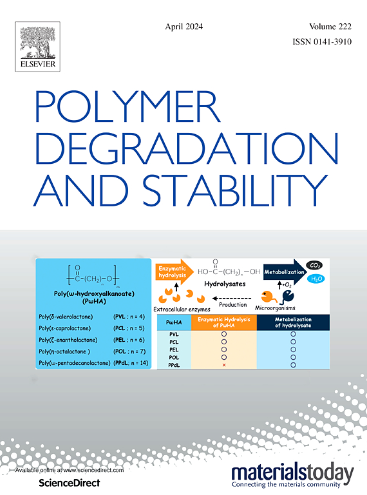受犰狳壳的启发,黑色磷纳米片穿上了Ar等离子防护服,增强了环氧树脂的防火安全性
IF 7.4
2区 化学
Q1 POLYMER SCIENCE
引用次数: 0
摘要
黑磷(BP)纳米片作为一种新型的二维材料,在聚合物纳米复合材料中具有显著的防火促进作用。本文采用等离子体清洗机(PC),配备Ar等离子体保护BP (PCBP),提高BP的环境稳定性。此外,环氧树脂(EP)的防火安全性也得到了提高。分子动力学模拟(MDS)结果表明,在0 K、200 K、400 K、600 K和800 K时,Ar等离子体与BP的结合能分别为-847.0148、-847.3044、-847.3012、-847.2975和-847.3035 eV。说明BP与Ar等离子体之间存在很强的静电相互作用,且不受温度的影响。电子顺磁共振(EPR)检测显示PCBP的自由基强度比BP降低,表明PCBP的环境稳定性优于BP。锥量热测试(CCT)结果表明,添加量为1.5 wt %的PCBP纳米片可显著提高EP的阻燃性能,峰值放热率(pHRR)和总放热率(THR)分别下降22.98%和16.24%。含1.5 wt% PCBP纳米片的环氧纳米复合材料可达到UL-94 V-0等级,极限氧指数(LOI)为30.4。热重分析(TGA)结果表明,残重率提高了23.27%。残炭层拉曼测试表明,ID/IG值从4.021下降到3.098,表明石墨化程度有所提高。这是由于物理屏障、自由基捕获和催化转化成焦的协同作用所致。本文章由计算机程序翻译,如有差异,请以英文原文为准。
Inspired by the shell of an armadillo-black phosphorus nanosheets weared Ar plasma protective clothing to enhance the fire safety of epoxy resin
Black phosphorous (BP) nanosheets as a novel two-dimensional material have revealed dramatically fire safety promotion in polymer nanocomposite. Herein, plasma cleaning machine (PC), equiped with Ar plasma, was applied to protect BP (PCBP) to enhance the environmental stability of BP. Further, the fire safety of epoxy resin (EP) was enhanced. The molecular dynamics simulation (MDS) results indicate that the values of binding energy between Ar plasma and BP at 0 K, 200 K, 400 K, 600 K, and 800 K were -847.0148, -847.3044, -847.3012, -847.2975, and -847.3035 eV, respectively. It meant that there was a strong electrostatic interaction between BP and Ar plasma, and it was not affected by temperature. Electron Paramagnetic Resonance (EPR) test revealed that the free radical strength of PCBP decreased than BP, suggesting that the environmental stability of PCBP was better than that of BP. The results of cone calorimetry test (CCT) displayed that the flame retardant ability of EP was enormously improved through the addition amount of 1.5 wt % PCBP nanosheets, for instance, the peak heat release rate (pHRR) and the total heat release (THR) were descended by 22.98 % and 16.24 %, respectively. Epoxy nanocomposite with 1.5 wt% PCBP nanosheets can achieve UL-94 V-0 rating level with a limit oxygen index (LOI) of 30.4. Thermogravimetric analysis (TGA) result displayed that the residual weight rate increased by 23.27 %. Raman test of the residual char layer proved that the value of ID/IG declined from 4.021 to 3.098, indicating a promotion in the degree of graphitization. These were attributable to the cooperation effect of physical barrier, free radicals trapping and catalytic conversion into char of PCBP.
求助全文
通过发布文献求助,成功后即可免费获取论文全文。
去求助
来源期刊

Polymer Degradation and Stability
化学-高分子科学
CiteScore
10.10
自引率
10.20%
发文量
325
审稿时长
23 days
期刊介绍:
Polymer Degradation and Stability deals with the degradation reactions and their control which are a major preoccupation of practitioners of the many and diverse aspects of modern polymer technology.
Deteriorative reactions occur during processing, when polymers are subjected to heat, oxygen and mechanical stress, and during the useful life of the materials when oxygen and sunlight are the most important degradative agencies. In more specialised applications, degradation may be induced by high energy radiation, ozone, atmospheric pollutants, mechanical stress, biological action, hydrolysis and many other influences. The mechanisms of these reactions and stabilisation processes must be understood if the technology and application of polymers are to continue to advance. The reporting of investigations of this kind is therefore a major function of this journal.
However there are also new developments in polymer technology in which degradation processes find positive applications. For example, photodegradable plastics are now available, the recycling of polymeric products will become increasingly important, degradation and combustion studies are involved in the definition of the fire hazards which are associated with polymeric materials and the microelectronics industry is vitally dependent upon polymer degradation in the manufacture of its circuitry. Polymer properties may also be improved by processes like curing and grafting, the chemistry of which can be closely related to that which causes physical deterioration in other circumstances.
 求助内容:
求助内容: 应助结果提醒方式:
应助结果提醒方式:


